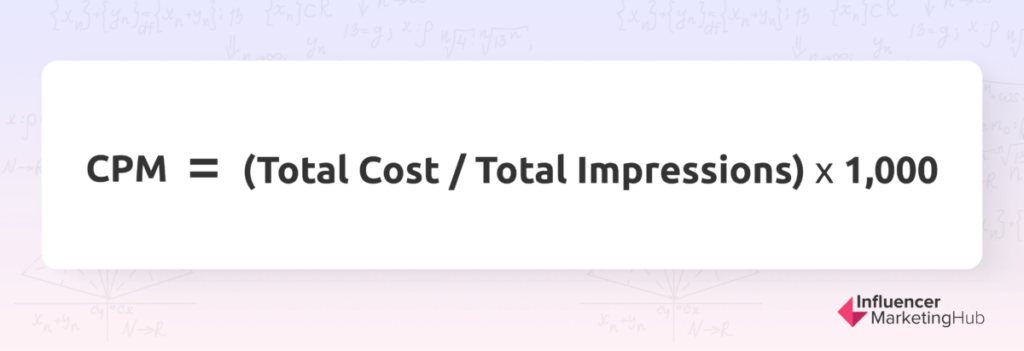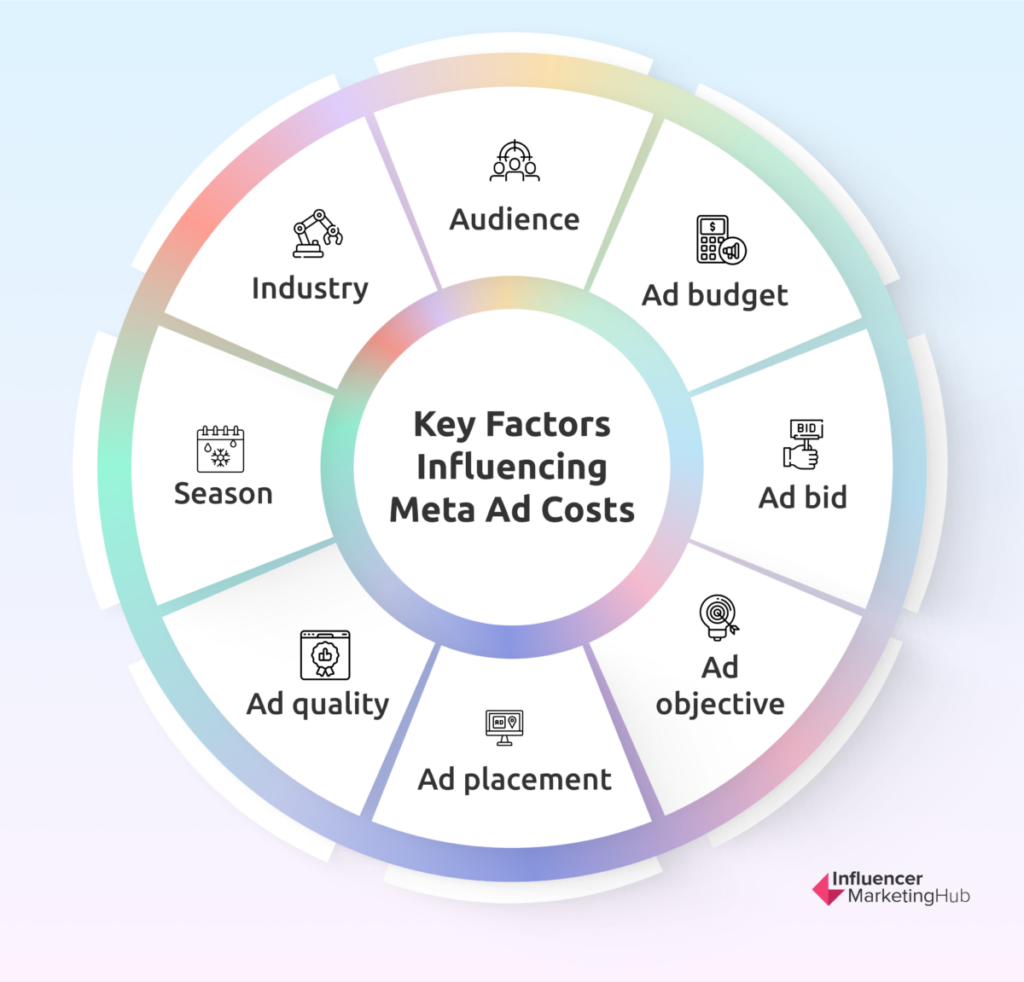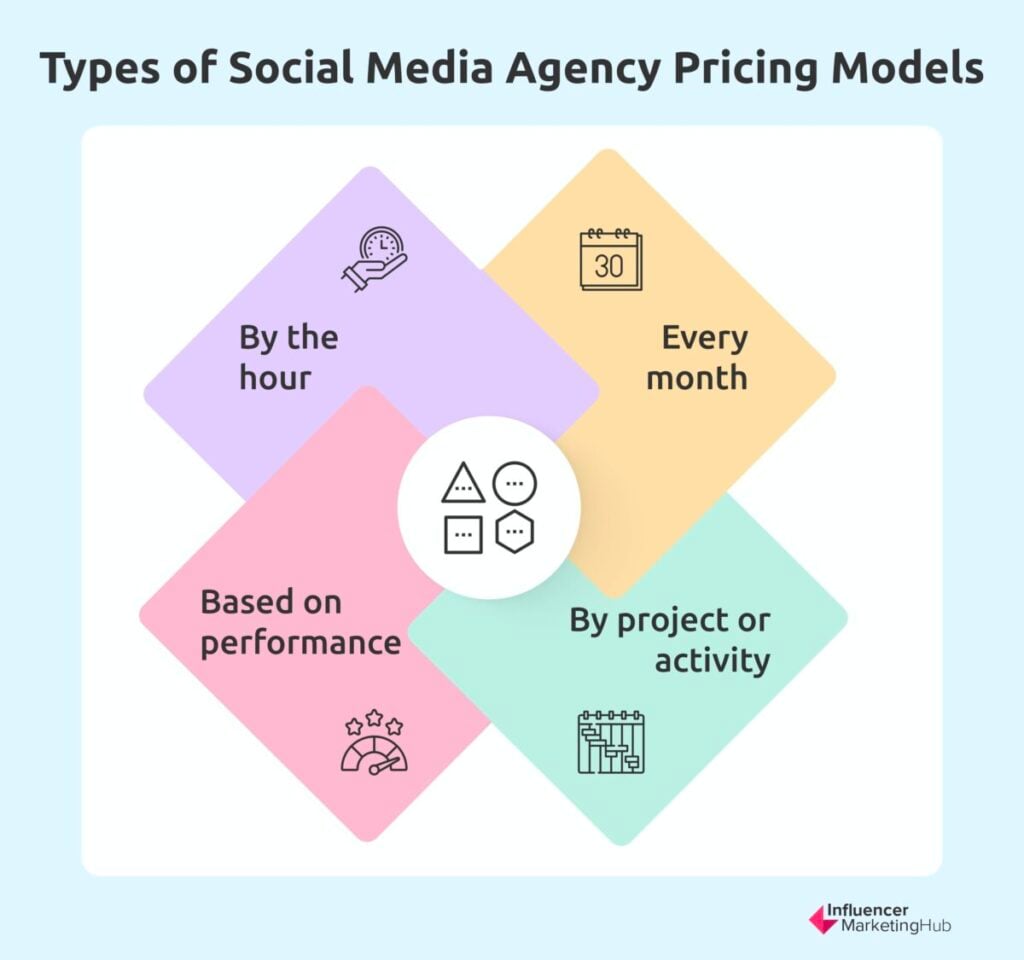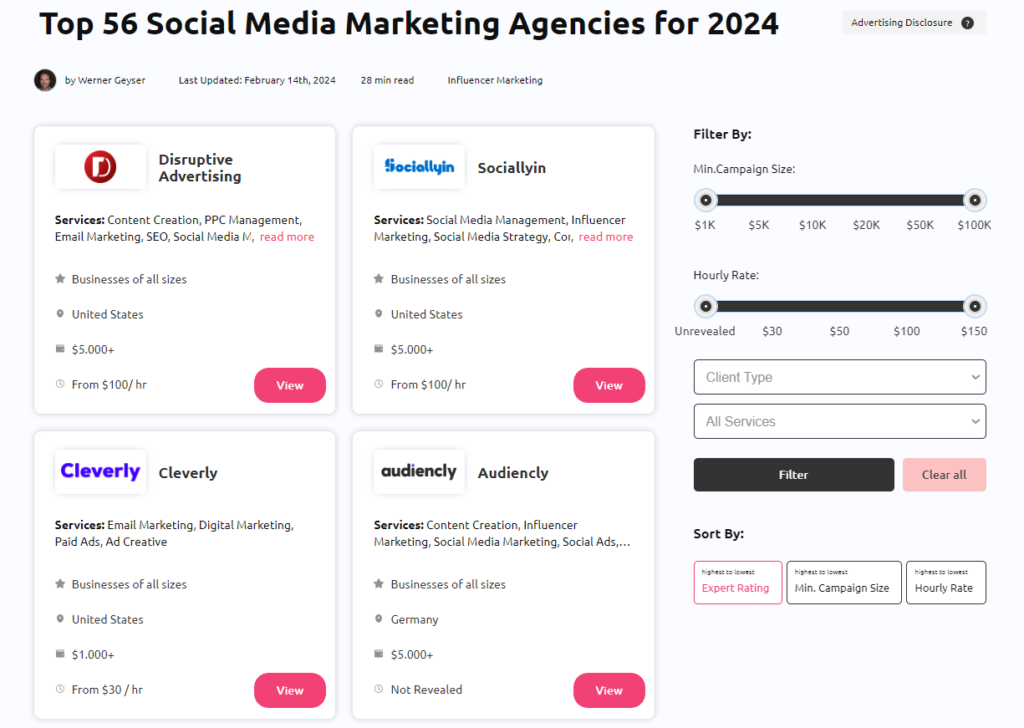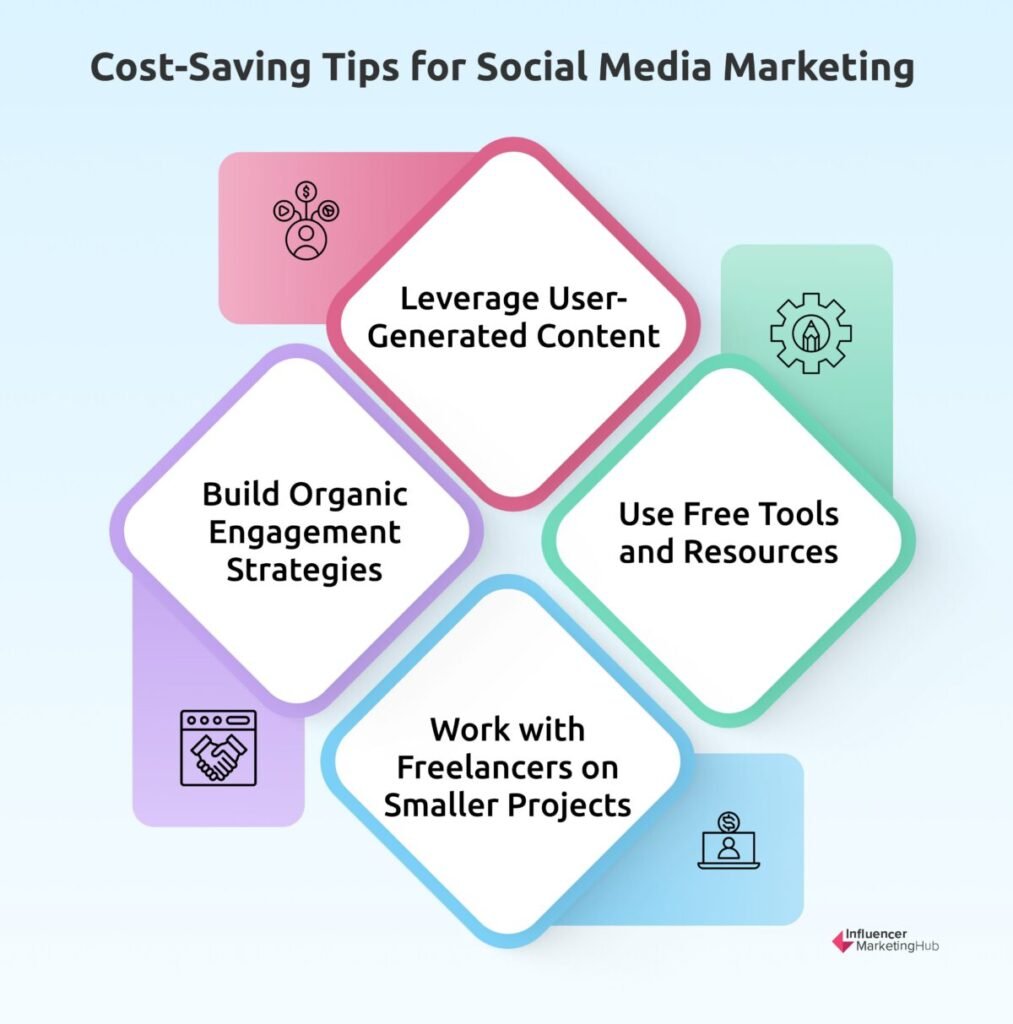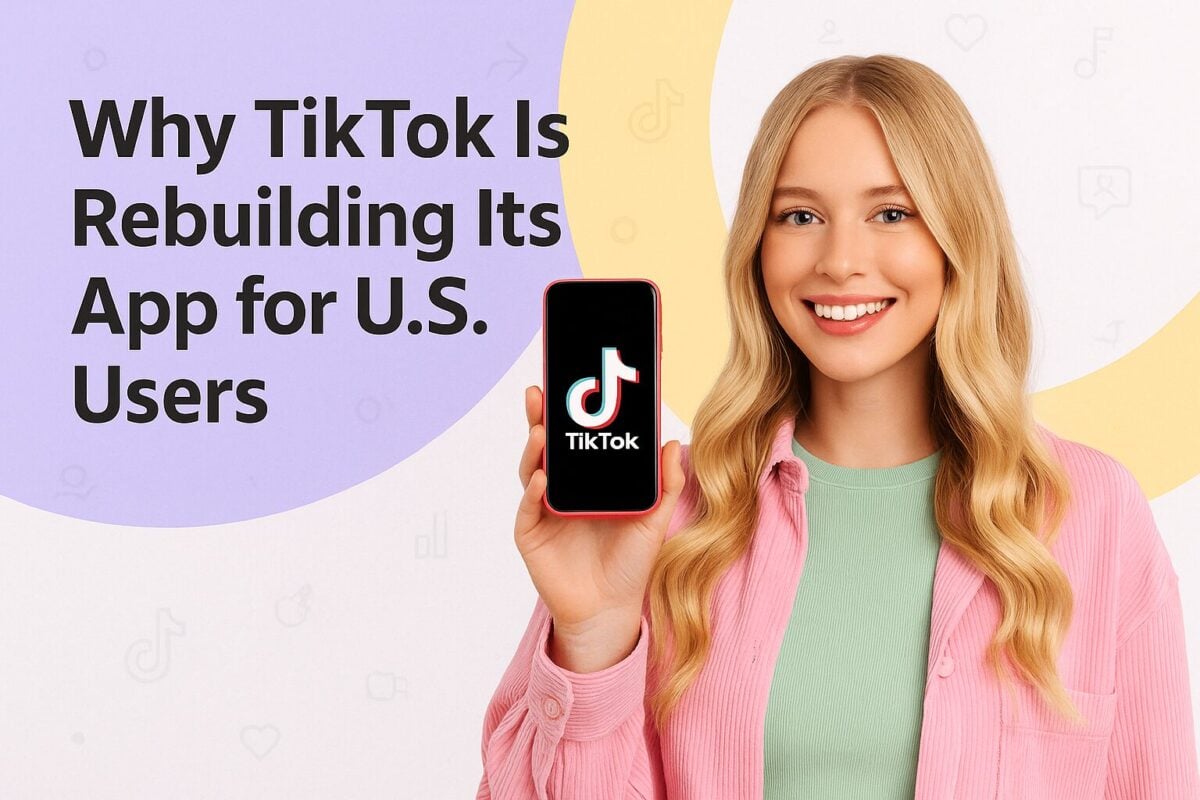At a time when business owners compete daily for online visibility and customer retention, brands can benefit from the expertise of professional social media marketers in scaling business growth. Marketing agencies possess the experience and knowledge to harness online tools to connect with your target audience, nurture leads, and convert them to customers.
Finding and selecting a suitable agency partner requires identifying the factors that affect their fees. After thoroughly understanding these elements, you must compare the costs against the benefits of working with your shortlisted prospects before making a final decision.
This article aims to help you grasp how third-party teams set their fees. Whether you'll outsource all or only part of your social media marketing to an agency, understanding the costs of hiring one can help you make an educated choice that fits your budget.
An Essential Guide to Identifying and Analyzing Social Media Marketing Costs:
Common Social Media Marketing Pricing Terms
Like many other types of marketing, social media marketing is replete with terms and acronyms relating to how much you pay for ads. To ensure that everybody has the same understanding, we include some of the more common ones here. You will find more details of some of these in our Social Media Glossary.
PPC Campaign – this is an advertising campaign where you pay a publisher or advertising network a sum based on the number of times people click on your ads.
CPC (Cost per Click) – used in a PPC campaign as the rate at which an advertiser pays a publisher for every click on an ad. CPC is calculated as:
CPC = Advertising cost/number of clicks
CPM (Cost per “Mille”) – Mille is Latin for 1000, so CPM represents the cost per 1000 impressions of a particular ad. We call this CPT (Cost per Thousand) in our glossary.
With CPM campaigns, you pay when somebody looks at your ad, rather than take the action of clicking on it, as you do with PPC/CPC campaigns.
oCPM (Optimized Cost per Thousand Impressions) – a special TikTok option similar to the standard CPM pricing model, but representing the cost per thousand impressions made by a group of users considered more likely to convert. With oCPM bidding, you can increase your reach and increase conversions simultaneously
CPV (Cost per video view) – used to represent the amount you have to pay when somebody watches your video ad
CPL (cost per lead) – used by Facebook for campaigns designed to generate email leads
CPS (Cost per Send) – used by LinkedIn as a measure of the cost per Sponsored InMail message sent.
CTR (Click Through Rate) – this is a metric that gives the ratio of clicks to impressions and is often a good proxy for how successful a PPC campaign is.
Conversion Rate – a conversion occurs when somebody takes an intended action as a result of your social media marketing ads. For example, if you advertise on Facebook, you create a new campaign in Meta Ads Manager. The first thing you are asked to do is Choose a Campaign Objective from a list given.
Your selection here will dictate your campaign objective. The most obvious type of conversion will relate to a Sales campaign objective (as increasing sales numbers appears very tangible to most people). However, you will have a conversion measurement for each of the other objectives as well.
For example, if you pick a Sales campaign, you will see a section in Meta Ads Manager where you can set up the details for your conversions:
Often your social media conversion will result in you sending people somewhere else (e.g. your website) to do a particular task, e.g.
- Download a free ebook
- Subscribe to a newsletter
- Answer a survey
- Leave a comment
The Conversion rate for your advertising campaign will be the percentage of people served with your ad who do the desired task.
5 Factors Affecting Social Media Marketing Agency Rates
Based on the latest WebFX marketers' survey, 66% of today's businesses earmark 5% to 25% of their marketing budgets on social media management. Fortunately, 86% expressed satisfaction with the return on their social media investment. Meanwhile, 94% of business leaders surveyed by Sprout Social said that social data and insights positively support their reputation-building and customer retention efforts. As a result, social media budgets can increase by up to 50% in the next three years, according to 44% of respondents.

Source: agencyanalytics.com
What are the costs that go into social media marketing? Here are the top five factors that determine how much you pay for outsourcing this service:
1. Work scope and contract length
Marketing firms typically set their fees based on the type, number, frequency, and duration of services you expect them to deliver. Social media marketing typically involves the services below:
- Developing a strategy—identifying your brand's target audience and creating a content plan with a cohesive brand message that resonates with that audience
- Conducting competitor analysis and market research for industry trends
- Creating or optimizing social media profiles
- Creating a content calendar and unique posts—ensuring they reflect the brand's verbal and visual tone—for various social channels and conducting performance tracking/analytics
- Running paid social campaigns
- Engaging with followers to understand the buyer's persona and providing customer support (including responding to queries, complaints, and reviews across platforms)
- Strengthening lead generation and creating a sales funnel or flywheel, depending on one's customer journey model
- Connecting with influencers or creators to expand the brand's reach
2. Platform selection
Different platforms have different management and advertising costs. Moreover, each channel requires specific content types, which affects production time and the resources to produce them. The rates we refer to here are what you pay each social media network for a paid advertisement on the relevant platform. They ignore any other costs you may face for social media marketing on the platform, for example paying a freelancer or agency to run your social accounts on your behalf.
1. Facebook and Instagram (Meta)
We will treat Facebook and Instagram together here, as you create ads for both using the Meta Ads Manager. When you create ads, Meta gives you various options for where you place your ads across Facebook, Instagram, and the Meta Audience Network (a collection of Facebook/Instagram-approved mobile apps and websites that show ads).
There are numerous types of ads you can buy for Facebook and Instagram, but the most common type is where you bid for advertising space in an instant auction. The ad auction determines which ads should be shown to which people.
Rates vary, depending on many factors. WebFX found that on average, people pay the following for Facebook ads:
- $0.26 – $0.30 per click
- $1.01 – $3.00 per 1,000 impressions
- $0.00 – $0.25 per like
- $0.00 – $5.00 per download
63% of WebFX’s respondents spend between $1.00 – $500.00 per month on Facebook ads. However, some companies spend upwards of $3000 per month.
Shopify has also written on this topic, however, they found different average costs (their figures relate solely to Facebook ads in February 2024):
- Facebook ads cost approximately 69¢ per click (CPC).
- Facebook ads cost approximately $9.88 per 1,000 impressions (CPM).
- Facebook ads targeting email leads cost approximately $8.87 per lead (CPL).
Metricool claims that the average cost for advertising on Facebook is between $0.26 – $0.30 per click, $1.01 – $3.00 per 1000 impressions, and $0.00 – $0.25 per like. In the case of Instagram, the average cost for advertising is between $0.20 to $6.70. For CPC or cost-per-click, advertisers pay $0.20 to $2 per click.
Meta’s own opinion seems to be that advertising costs are complicated.
They say, “When you advertise on Meta technologies (i.e. Facebook, Messenger, Instagram, or Meta Audience Network), you decide how much you want to spend on advertising. Meta then tries to get you as many results as possible for that amount.” They also emphasize that some types of advanced ads require a minimum amount of spend to work.
There are multiple factors affecting the exact price you will pay for your Meta ads including:
- Audience – your target audience plays a major factor in determining the price of your ads. WebFX gives an example of how targeting women adds $0.15 to your CPC compared to targeting men. Meta includes extensive targeting options, meaning that you can target a highly specific audience for your ads (but the CPC/CPM increases accordingly).
- Ad budget – the greater the budget you allow, the more competitive your bids can be (the more options you have in the automatic auctioning process).
- Ad bid – as part of the ad setting process you are asked to pick one of two bid strategies, (Automated Bidding or Manual Bidding). Manual bidding helps you reach a desired CPC but can lead to higher advertising costs.
- Ad objective – when you set up your Facebook/Instagram ads you have to pick one of more than ten objectives for your ad campaign (under the broad categories of Awareness, Consideration, and Conversion). Some objectives give more valuable results for a business than others, and this flows through to ad costs.
- Ad placement – you can opt to place your ad at various places across Facebook, Instagram, and Audience Network apps, which affects your ad costs. Instagram placement tends to be more expensive than on Facebook. According to WebFX, you’ll pay an additional $0.80 on average for your ad to appear on Instagram.
- Ad quality – Meta gives ads a relevance and engagement score. The better this score, the less you will have to pay for your ads – you can out-bid advertisers with poorer relevance and engagement scores, even if you bid a lesser amount. Higher quality, more relevant ads, can win ad slots for lower prices than other bidders can achieve.
- Season – the price you pay for your ads typically rises during peak shopping seasons, as there is usually more competition for ad space.
- Industry – the CPC in some industries (like finance & investment ($3.77 average) and home improvement ($2.93)) is higher than in others (e.g. apparel ($0.45) and travel & hospitality ($0.63)) – WebFX figures.
2. X (Twitter)
There is no minimum spend required for X Ads. What you will be charged for depends on the campaign objective and ad group goal you choose.
Each campaign objective and ad group goal combination has a different billable action, and X only charges you when that action occurs.
You can currently select from nine objectives across Awareness, Consideration, and Conversion. For example, you might want to drive more link clicks. In that case, you would select the Consideration objective of Engagement, and pay a rate per engagement.
Like Facebook, X uses auctions for ad spots. The factors that affect what you pay for your campaigns include:
- How engaging your ad is
- The size of your targeted audience
- How many other advertisers target the same audience as yourself
- How much you bid
WebFX found that on average, X advertising typically costs $0.26 - $0.50 per first action and $1.01 - $2 per follow for promoted accounts. On average, X advertising costs WebFX’s respondents $101 – $500 per month, although over 10% of respondent businesses spent more than $10,000 per month.
3. TikTok
We have previously written about how much TikTok ads cost. You must spend at least $500 to advertise on TikTok. You need a minimum daily budget of $50 at the campaign level and a minimum of $20 per day at the ad group level.
As with other social networks, TikTok operates an auction system for its in-feed advertising slots. Depending on your goal, you can make a bid based on CPV (to increase video views), CPM (to spread brand awareness and reach), oCPM (to increase conversions and expand reach), or CPC (to increase conversions).
Varos has calculated the average cost for in-feed ads on TikTok (when using CPM). The average CPM on TikTok is $9.16 (as of November 2023), with TikTok advertising prices starting at $0.50 CPM and $0.02 cost per click.
TikTok also offers other ad types. These have a flat fee and cost considerably more. A branded takeover or branded hashtag challenge can cost $150,000.
4. YouTube
YouTube is owned by Google, and you can create YouTube ads in your Google Ads Manager account.
As with many of the ad platforms here, it is difficult to give a simple YouTube ad cost – there are too many variables to consider. According to LocaliQ, YouTube advertising can cost (on average) from $0.10-$0.30 per view (CPV), with a CPM of $4-$10. The average business sets a $10 to $50 daily budget for its YouTube advertising campaign.
The main factors affecting the cost of using YouTube ads include:
- YouTube advertising campaign goals.
- Upfront costs associated with video ads.
- The type of YouTube ad you’re running.
- Your YouTube advertising audience targeting.
- Your daily YouTube advertising budget.
5. LinkedIn
LinkedIn operates a bidding system for advertising on its platform, in much the same way as Meta’s for Facebook and Instagram. Therefore, the actual cost you pay will depend on how your bids rank in an ad auction.
LinkedIn suggests that new advertisers begin with a $US25 budget. Existing advertisers should start at least a $50-$100 campaign (if using USD), although they say that the equivalent of $US25 should be sufficient in other currencies.
You can select from three main ad types on LinkedIn:
- Sponsored Content (Single Image Ads, Carousel Ads, Video Ads, and Event Ads)
- Text & Dynamic Ads
- Sponsored Messaging
According to 2022 benchmarks, Sponsored Content has an average CTR of 0.44%. Sponsored Content typically falls between $8 and $11 per click. If you’re targeting a niche or in-demand audience, these figures often increase to $15 – $20 per click.
Text and dynamic ads appear on the right side of a desktop display only. Text ads are very small – dynamic ads are about three times as big. Text Ads typically see a 0.025% CTR on average, compared to a 0.08% rate for dynamic ads. Unsurprisingly, text ads are LinkedIn’s cheapest ads. Prices for text ads typically range from $3-$6 a click (or thousand impressions). Dynamic Ads cost more, reflecting their greater size: $6 – $8 per click.
Sponsored Message ads are sent to users’ personal LinkedIn inboxes, where they have an average open rate of 55%. Any action within a message is considered a click, and CTRs for Sponsored Messages typically average 3.2%. This equates to an average CPS (Cost per Send) of $0.50-$1 and CPC of $25-$60.
In addition to ad type, the cost you will pay for LinkedIn ads also depends on:
- Your target audience (and how active your competitors are at marketing to them);
- Your campaign objective (or “Optimization Goal” as LinkedIn refers to it);
- The bidding strategy you select (choose from maximum delivery bidding, manual bidding, and cost cap bidding);
- Your Ad Relevance Score – LinkedIn favors high-quality, relevant, engaging ads in its auctions (similar to Meta’s approach). So, a high-quality ad may win an advertising slot for cheaper than a lesser-quality one (even if you bid the same amount on each ad).
Depending on the Optimization Goal you choose, LinkedIn can bill you in various ways:
- Brand awareness – CPM
- Traffic to the website – CPM or CPC
- Commitment – CPM or CPC
- Video Views – CPM or CPV
- Lead Generation – CPM or CPC
- Conversions on Site – CPM or CPC
Here’s a list of going monthly rates for specific types of social media management:
Service | Basic Monthly Pricing | Monthly Pricing with Ads |
Platform management | $5,000 and up | |
$500 to $3,000 | $2,500 and up with ads | |
$500 to $3,000 | $1,000 and up with ads | |
YouTube | up to $1,000 | $1,000 and up with ads |
X (Twitter) | $500 to $2,500 | $900 and up with ads |
$500 to $4,000 | $2,000 and up with ads | |
TikTok | $1,000 and up with ads | |
$500 to $200 | $500 and up with ads | |
Snapchat | up to $250 | or $1,000 and up with ads |
Content creation | $6,900 and up | |
Blog post | up to $500/post | |
Video content | up to $2,000/post | |
Infographics | up to $80/graphic |
3. Client size
Agencies also consider a company's size when determining its rates. A company's social accounts and followers typically increase as the business grows larger.
Services for small businesses may reach up to $2,500 monthly, while fees for medium-sized firms can be around $2,500 to $7,500 monthly. The asking fee for large entities can run from $7,500 to $20,000 monthly. Marketing firms with enterprise-level clientele generally have more sophisticated tools for managing multiple accounts and bigger teams with members of various specializations. Although some agencies offer to audit your social media—one platform—for free as part of their discovery phase or free initial consultation, others charge from $600 based on your business size.
4. Pricing model
Social media agencies use any combination of these pricing models when billing clients:
-
By the hour
Most social media freelancers, one-person consultancies, and smaller agencies bill by the hour. Some full-service digital marketing firms charge hourly rates for customer service support and website maintenance. Consider partnering with a team that offers this pricing model if you’re a startup or small business with fluctuating or occasional needs and a limited budget. This option is advisable when you must identify your target audience, develop strategies, and do other intensive research.
-
Every month (monthly retainer)
Hiring an agency on a fixed monthly fee is advisable if you need ongoing support in maintaining a consistent social media presence. This setup typically includes performance monitoring, analysis, and reporting to prove that your campaigns are hitting (or exceeding) targets. Monthly retainers usually involve a package of various social media services done simultaneously.
-
By project or activity
Some agencies agree to produce output for a one-off activity instead of monthly or yearly. The project-based pricing works best for new product launches, targeted marketing campaigns, and related tasks with a well-defined end date and budget. Ask your agency about their payment terms if you add something or make any changes to the initial project scope.
-
Based on performance
Some agencies agree to receive payment based on meeting your pre-defined goals. While this practice is becoming popular, it's also risky. Be sure you understand and agree on campaign success metrics—engagement rate, follower growth, conversion rate, and others. Also, be ready with an extended payout timeline—social campaigns typically take at least three months before you can see results.
5. Location
Rates may be higher in urban areas and similar locations with a high cost of living. The demand for social media marketing services—therefore, competition—is high in these areas.
Cost-Benefits Analysis: Deciding on the Best Investment
After getting an overview of current service rates and payment schedules, it's time to decide what to invest in and how much you're willing to spend on those services. One effective way to do this is to conduct a cost-benefit analysis. List all the potential benefits of your decision, and then subtract all associated costs. As a data-driven approach, a cost-benefit analysis also identifies the most advantageous endeavors. This way, you can define your project's feasibility—primarily if it’s within your budget—and allocate resources based on priorities. Your analysis should include the following steps:
1. Define your scope of work.
Providing your chosen agency with specific details about your social media marketing requirements enables them to give you an accurate quote. Here are some questions your partner firm is likely to ask you. Discuss them with your staff ahead of your agency’s discovery call.
- How does your target consumer buy online—on what channels are they on?
- How many social accounts would you want to grow?
- How intense would you like your presence to be?
- What is the current state of your existing channels?
- How many social media content experts do you have in your team?
- What content types (written content, videos, images) do you want the agency to create?
- What kind of campaigns would you want to run?
- Do you plan to place social media ads?
- How many social media posts do you want to publish daily?
- Do you plan to collaborate with influencers? If yes, at what caliber should they be?
2. Identify costs and benefits, assigning dollar values to each.
Costs and Benefits of Outsourcing Social Media Marketing | |
Costs of Services Required from an Agency Based on Social Media Goals | Benefits or Potential Outcomes |
|
|
Quantify or determine the cost of each required service and do the same for your expected outcomes. Our listicle of the top 56 social marketing agencies can give you an idea of outsourcing costs. Each listing features the agency's profiles—including their pricing—so you can compare fees, services offered, and specialization.
Some agencies feature case studies break down advertising costs and resulting growth in lead generation and sales. Here is an example from Ninja Promo.

Source: ninjapromo.io
Meanwhile, you can use social media analysis tools to analyze the performance and benefits of your campaigns—particularly ROI estimates. See how Hootsuite and Agorapulse display generated revenues on their user dashboards.

Source: blog.hootsuite.com

Source: agorapulse.com
3. Compare costs and benefits and calculate the net benefit.
Subtract the total costs from the total benefits to get your net benefit. In general, expenses should be less than 50% of the benefits. The payback period (time needed for the benefits to repay the cost) must not exceed one year. An agency’s partnership would be worth it if its proposed service package meets both conditions.
For this step, involve concerned stakeholders in your marketing plan's outcome. Senior leaders can weigh options according to business values, culture, and goals.
4. Conduct a sensitivity analysis.
A sensitivity analysis tests different scenarios or alternatives, as well as the scope of each alternative. You could analyze the impact of choosing another agency or a different set of platforms than what you initially selected. This analysis also considers a project's opportunity cost (the value of the next best alternative) and long-term risks.
Other Tips for Maximizing Your Social Media Marketing Budget
If a cost-benefit analysis is too complicated for you, you can take these other steps to help you verify if you'll be able to afford the services of an agency:
1. Do market research.
You can use your customer relationship management platform to review where your audience spends most of their time. Conducting surveys can also indicate your consumers' preferred channels and offers. Also, research and analyze competitor spending to determine industry benchmarks.
2. Track your content's performance.
Stay updated about your followers' evolving interests by consistently monitoring your social media analytics. Check the days and hours when they're most engaged on a platform using its built-in analytics features. These tools can also help you discover the types of organic and paid content that appeal to your audiences the most.
Tips for Reducing Social Media Marketing Costs
Managing social media marketing costs is crucial for maintaining a healthy marketing budget. Here are some effective tips to help you reduce expenses:
Leverage User-Generated Content (UGC)
Encourage your customers to create and share content about your brand. UGC is authentic, engaging, and free, helping you cut down on content creation costs.
Use Free Tools and Resources
Take advantage of free social media management tools and resources. Platforms like Hootsuite, Buffer, and Canva offer free versions that can significantly reduce your expenses.
Work with Freelancers on Smaller Projects
Instead of hiring an agency for every task, consider working with freelancers for smaller projects at the beginning at least. Freelancers often offer competitive rates and can provide high-quality work without the overhead costs of an agency.
Build Organic Engagement Strategies
Focus on creating content that naturally engages your audience. Organic strategies like community building, interactive posts, and consistent engagement can drive significant results without the need for paid advertising.
By implementing these cost-saving measures, you can maximize the impact of your social media marketing efforts while keeping your budget in check.
Manage Costs Through Cyclical Budget Planning
Your social media marketing budget is a dynamic document that needs periodic review and optimization. Monitor trends and insights from data analysis to check whether your strategy still fulfills your goals. Depending on your campaigns' performance, you can scale back and modify your poorly performing approaches. You may also consider investing more in strategies that yield positive results. When you have more funds, you can experiment with new content based on research findings and social listening.
Frequently Asked Questions
What is a social media agency's edge over a social media manager?
Your social media marketing goals and the activities required to fulfill them will determine whether you need to work with an agency or hire an in-house specialist. The top benefit of recruiting specialists is their availability and the in-depth knowledge they develop about your brand as they embed themselves in your organization. Because social media managers focus on your company's social community, they can quickly respond to comments or industry developments. A full-time manager is advisable if you prefer a short waiting period for feedback and more control over the strategy, brand voice, and messaging.
Meanwhile, agencies can give impartial advice and fresh perspectives due to their experience. Moreover, they can do the job at a lower cost, especially if they only need to manage a few social accounts. At the same time, they have the resources and expertise to execute large-scale campaigns. Internal specialists who work on multiple tasks at once might spread themselves thin, resulting in poor-quality output.
How do agencies onboard new social media marketing clients?
To start their relationship with brands on the right foot, agencies conduct an onboarding process using a questionnaire to help them know more about their clients. The questionnaire typically covers:
- The client’s social media history: past social media agencies they partnered with
- The technology and analytics they have access to
- Their current social media strategy
- Any damage control that needs to be urgently implemented
- Their audience or followers' demographics
- The types of posts their followers engage with
- Their brand story
- Their expectations from your partnership
Are there any "hidden costs" I must be aware of?
Hidden costs in social media marketing aren't really "secret." You just need to be more aware of them because they can be easy to overlook on pricing pages. These expenses include:
- Setup or onboarding fees, which are one-off costs to install or integrate the agency's system with your office marketing systems.
- Ad spending or payments for ads don't always appear on retainer fees. They can be worth $50 to $100 daily or over $1,650 monthly.
- Additional channels (verify if your service agreement/agreed payment covers all or one social platform only)
- Influencer fees (check whether you must pay per post or for a longer-term contract covering several months)
- Premium customer support for on-demand assistance from an account manager
